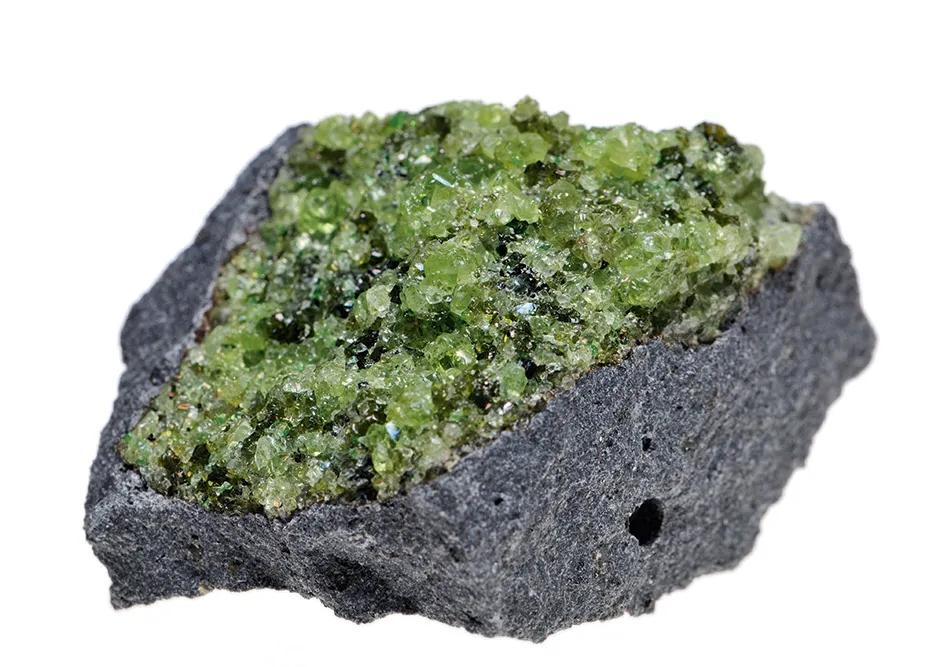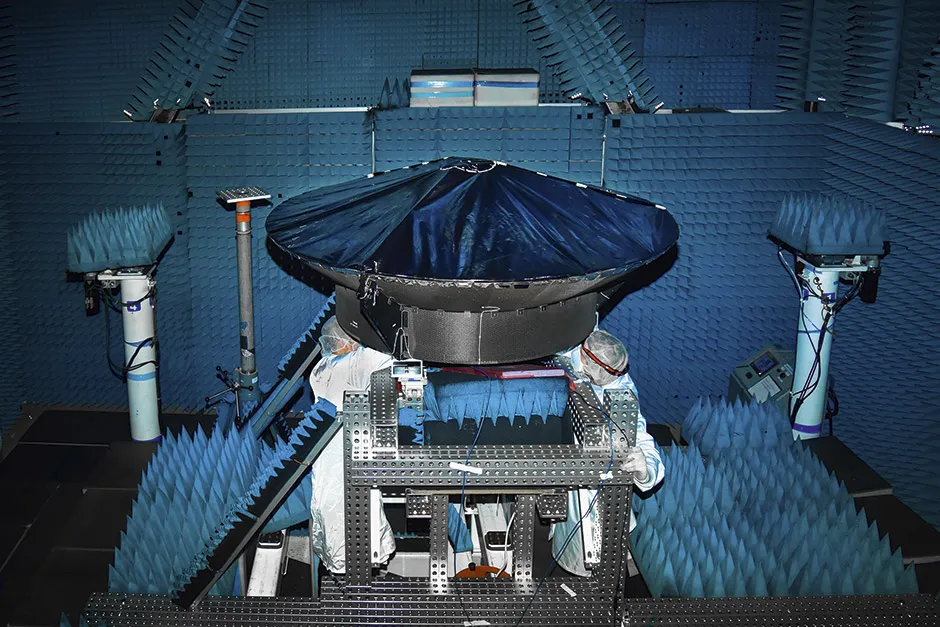Take a moment to imagine a giant lump of metal, 25 times larger than Mount Everest, floating through space. Finding it difficult to conjure an image? Don’t worry, nobody can. That’s because no one has ever seen such an object up close before. But five years from now, all will be revealed.
January 2026 is the target date for a new NASA spacecraft to arrive at an asteroid called Psyche. Named after the Greek goddess of the soul, Psyche was discovered on 17 March 1852 by the Italian astronomer Annibale de Gasparis. It’s one of the most massive bodies in the asteroid belt between Mars and Jupiter. Modern estimates suggest it contains about 1 per cent of all the mass spread across the millions of asteroids in the main asteroid belt. Yet it’s the asteroid’s composition that makes Psyche special.
Roughly 230km in diameter and shaped like a potato, Psyche’s density is so great that astronomers think it must be made of metal. Also, when astronomers look for the signature of rocky minerals, by analysing the sunlight bouncing off its surface, they can find none of the telltale markers they’re looking for.
If Psyche truly is metal, and it’s been studied so much now that there appears to be little doubt, then it could hold secrets about the way planets, including Earth, formed 4.6 billion years ago. Unlocking those secrets is what’s driving the Psyche mission.
When astronomers turn their thoughts to how Psyche could have formed, there’s only one place they know of where such concentrations of metal can exist. And that’s in the hearts of rocky planets, such as Earth, Mars and the other worlds of the inner Solar System.
Read more about asteroids:
If you could take a slice through one of these worlds, you would find a metallic core, surrounded by a deep silicate layer, known as the mantle, and then a thin rocky crust. Whereas the core is predominantly made of iron and nickel, the mantle features the mineral olivine and the crust is mainly composed of basalt.
This layering is produced by a process called differentiation. Differentiation is thought to take place in the final stages of planet formation, when the planets are molten. In this state, dense material, such as metal, sinks to the centre while lighter material, like rock, floats to the surface.
So could Psyche have once been inside a fledgling planet that was smashed to smithereens early in the history of the Solar System? That’s what the Psyche mission is designed to investigate. It’s a high-stakes game, because if this scenario turns out to be true, astronomers have a lot of explaining to do.

“It’s called the missing mantle problem,” says Dr Julia de Leon, an asteroid scientist from the Instituto de Astrofisica de Canarias, La Palma, and part of the Near Earth Object Modelling and Payloads for Protection (NEO-MAPP) project.
The argument runs like this: if Psyche really was part of the core of a shattered planet, then where’s the rest of the debris? Most of the asteroids in the Solar System are primitive, undifferentiated bodies. We see very few olivine-rich asteroids that would represent the mantle material for a shattered world.
It gets worse. A substantial fraction of the meteorites that have been falling on Earth for aeons are made predominantly of iron – exactly as expected from the core of a disrupted world. But when scientists analyse them for traces of other chemicals, the results are so diverse as to be shocking.
“The analysis suggests that the iron meteorites might have come from at least 50 or 60 different cores,” says de Leon.
On the face of it, that means 50 or 60 planets that were smashed to pieces during the formation of the Solar System. It just seems too much considering that astronomers can’t find enough mantle fragments to account for even one of these doomed worlds. This is the conundrum that the mission to Psyche must try to unlock.

The pathway to the mission began a decade ago, when Dr Lindy Elkins-Tanton, a planetary scientist from Arizona State University gave a lecture at the Lunar and Planetary Conference in America. Together with colleagues, she was presenting a new hypothesis for differentiation. In her view, smaller asteroids – rather than almost complete planets – could generate enough heat to at least begin the process of melting and differentiating.
The key to the idea was the mounting evidence that there had been an abundance of aluminium-26, a radioactive isotope produced in the explosion of stars, present at the origin of the Solar System. It suggested a nearby star had exploded shortly before the Solar System began forming.
As those first planetesimals formed they naturally included quantities of the radioactive aluminium, and like any isotope its decay would generate heat. This heat then melted the interiors of some planetesimals, allowing them to differentiate on the inside, but, according to Elkins-Tanton, they might not have been completely molten, and so the outside remained undifferentiated.
Hence, when these asteroids were smashed in subsequent collisions, they revealed iron cores, but the surrounding rocks still looked primitive, solving the missing mantle problem.The idea sparked a healthy discussion at the conference and an unexpected offer. A couple of scientists from the Jet Propulsion Laboratory emailed her out of the blue to say they would like to propose a mission to test the hypothesis. “Let’s go out into the asteroid belt and see if we can find out whether this happened and where it happened,” says Elkins-Tanton.
And that was the beginning of the mission. Elkins-Tanton became the principal investigator and is currently in the final phases of shepherding the mission to its launch, in August 2022.

The mission is equipped with a suite of science instruments. There’s a multispectral imager that will provide high-resolution images at a variety of wavelengths. This will allow the team to identify and distinguish areas of exposed metal and rock on Psyche’s surface. Since no one has even seen an asteroid of this type before, no one knows how it’ll appear.
“I can’t wait to see what the surface of Psyche looks like. It could be really quite unusual and strange. I’m hoping that it’ll look totally bizarre,” says Elkins-Tanton.
The images could show large provinces of exposed metal. In which case, the craters that cover other asteroids could look odd here, because impacts happen differently in metal to rock. “We’d expect to see some quite strange shapes,” says Elkins-Tanton.
The pulverised rock, known as regolith, created in such impacts could also be missing at Psyche as it’s not clear whether metal can form a regolith. It all makes predicting what the asteroid will look like very difficult.
There’s also a gamma ray and neutron spectrometer that will measure the chemical elements on Psyche’s surface, giving us an estimate of its overall composition. This is the data that de Leon is most excited about because while the multispectral imager will identify areas of rocks and metal, the spectrometer will give the composition of the metal and reveal what has happened to it. “Only the chemical analysis can tell you this information,” she says.
Then there’s the magnetometer, which will detect whether Psyche has a magnetic field – crucial for understanding its past. The reason is that a molten iron core acts like a dynamo and generates a magnetic field. This is happening beneath our feet in Earth’s core even now.

As a core radiates away its energy and solidifies, parts of the resulting solid iron mass will retain an imprint of that magnetic field. “If we find that strong magnetic field at Psyche, then we’ll know right away that it was a part of core and then we can build upon that. So that would be a beautiful thing to find out right away,” says Elkins-Tanton.
They’ve certainly got their work cut out. Not only must they investigate the origin of Psyche, and try to explain the missing mantle problem, there’s also a family of meteorites that could have come from the same parent body as Psyche. They’re called the CB chondrites and they display a very high percentage of metal surrounding round droplets of rock. One idea is that they are ‘splashes’ from the same collisions that unearthed Psyche.
It’s an incredible thought that missions like Psyche are putting us in a position to examine the asteroid belt with such precision that, not only will we understand the general process of planet formation, but we’ll also be able to link different bodies to specific events and each other.
The other incredible thought about this mission is to prepare for the unexpected. As Elkins-Tanton says, “The thing that I’ll add here, which I always add, is that almost certainly everything I’m telling you right now is wrong. And that Psyche is gonna surprise us and show us that it’s something totally different altogether.”
And when all is said and done, that is perhaps the most beautiful thing about science.
- This article first appeared inissue 362ofBBC Science Focus Magazine–find out how to subscribe here
Read more about the future of exploration:
- James Webb Space Telescope: Inside the high-stakes testing of Hubble’s £7.2bn successor
- Deep-sea mountains: Earth’s unexplored ecosystems that are teeming with life
- How scientists are using cosmic radiation to peek inside the pyramids
- How humanity will return to the Moon: The future of lunar exploration
- Frozen lakes and underground waterfalls: Inside the Dark Star deep cave system